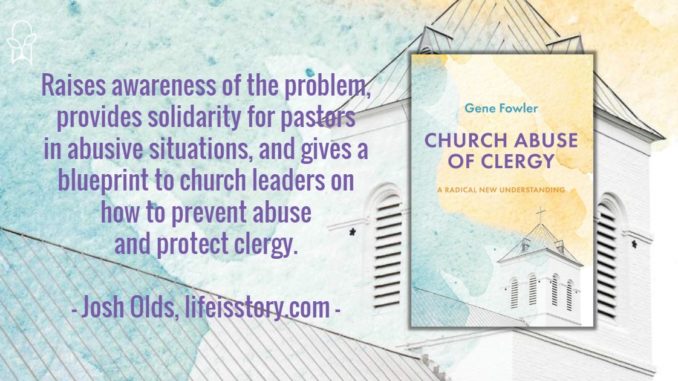
Published by Cascade Books on March 9, 2020
Buy on Amazon
Goodreads

Imagine receiving a shocking email from a church member stating that you, the pastor, have mishandled church funds and that you should resign for the good of the congregation. Soon you discover that the church member sent the email to many other church members. Additional lies will follow until the fateful day comes when the members vote to fire you, or the bishop dismisses you, or you resign for sheer survival. You are experiencing church abuse of clergy, which is the topic of this book.Clergy will gain an entirely new understanding of church abuse of clergy that afflicts many pastors and their loved ones by reading this book. The view of church abuse of clergy being presented is a new paradigm that challenges older explanations of the church abuse.This book shows that clergy must begin collaborating in order to discover effective solutions to the church abuse of clergy problem. Clergy must become empowered to confront the church at all levels and support one another in the face of church abuse of clergy. A very toxic ministry situation exists throughout the United States and internationally, which must be challenged!
There’s been a lot of ink spilled in recent years about emotional, spiritual, and sexual abuse by clergy—and all of it well justified—but a part of the conversation that often goes unspoken are all the clergy who find themselves emotionally and spiritually abused by their congregations. Sometimes under the guise of “servant leadership,” pastors, particularly in small churches, are asked to do everything. In Church Abuse of Clergy, Gene Fowler seeks to raise awareness of the problem, provide solidarity for pastors in abusive situations, and give a blueprint to church leaders on how to prevent abuse and protect clergy.
I first became aware of this book as I research for my doctoral dissertation, which takes a critical view of the way “servant leadership” is used and how clergy are often separate from the social community of the churches they serve—usually to the detriment of their mental health. Fowler approaches some of the same issues from a slightly different perspective, but shows how the outlook of pastors providing a service rather than providing friendship and spiritual leadership can lead to abuse situations.
Church Abuse of Clergy begins with an exploration of the scope of the problem. Fowler draws heavily from G. Lloyd Rediger’s book Clergy Killers, providing an extensive review/exploration of the book to set the parameters of the conversation. While Fowler adequately draws from Rediger’s work, this chapter would have been stronger had Fowler not relied on such dated material. Clergy Killers was published in 1996, while Church Abuse of Clergy released in 2020. On one hand, Fowler’s use of the book shows that the concept of abuse of clergy is not new and the fact that Rediger’s quarter-century old book remains the most relevant text is telling how the subject has been neglected in the literature. On the other hand, no matter how seminal a text may be, twenty-five years dates a lot of the material and calls into question if the problems of Rediger’s generation remain the problems of Fowler’s generation. The next chapter mitigates this a bit, providing details on church abuse of clergy from other studies, but it’s overall very heavy on one piece of the literature.
The second part of the book explores how recognizing church abuse of clergy can help mitigate its effects. Fowler also explores what sort of dynamic leads to abuse of clergy within a congregation. One of the conclusions is that most abuse is unconscious, simply a product of the cultural environment in how the church/denomination views the pastoral role. Further, congregants are unaware of their abuse because pastors often refuse to call out such abuse—whether out of a misplaced sense of leadership or out of fear of their jobs.
The final part of the book explores potential solutions to changing church culture to prevent and mitigate church abuse of clergy. It calls on congregations to be open to correction and collaborative with clergy in developing systems for caring for spiritual leaders. In sum, Church Abuse of Clergy advocates bringing pastors into the fold of the congregation and engaging with them as human beings and friends—the same conclusion as my own doctoral work.
Overall, Church Abuse of Clergy would have benefitted from a more engaging writing style and a more conversational tone. I hope that pastors drawn to the title because of their situation would find the courage to speak with their leadership teams of elders and deacons to advocate for themselves. This book would also be of use to denominational leaders trying to pinpoint problem congregations and cultivate a healthier work environment for their clergy.
